I first saw Spirited Away when I was about 5 years old, back before I even recognized the difference between Japanese and American animation. It’s beyond my recollection whether this was the first film from Studio Ghibli and director Hayao Miyazaki that I’ve watched, but it is the only one that has remained—at least in small disconnected, hazy fragments—a part of my memory. Last December, after discovering the VHS tape buried in a closet, I saw the film once more and it astounded me. When the tape ejected, I wanted to immediately push it back and see it again. Instead, I decided to hold my breath and wait for another time. And in the 300 or so days I spent waiting, the movie sat simmering in my head. And without realizing, I sat patiently right through the film’s 15th anniversary. And like a shining light, at the end of November in 2016, with my academic stress at its peak, it was announced that Spirited Away would be screening again in theaters for a limited time. It was time to stop waiting.
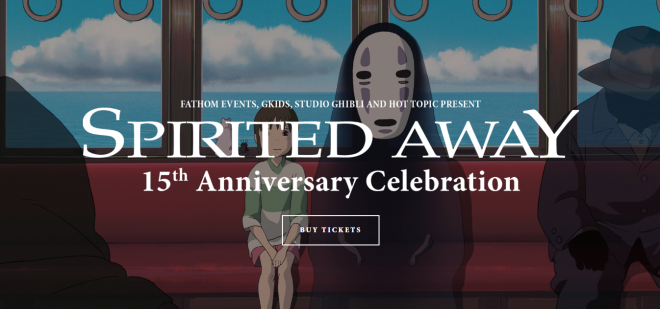
Spirited Away is a 2001 animated film from Japan, produced by Studio Ghibli and directed by Hayao Miyazaki. It has won several awards including an Oscar for Best Animated Feature, and to this day, it is the highest grossing film ever made in Japan, with a box office total of over 30 billion Japanese yen. In it, a young girl named Chihiro and her parents find themselves lost in a world of spirits, and in order to free her parents from a curse, she is forced to go to work in a bathhouse run by an old witch. Now, I wrestled a lot over why this movie had such an effect on me, and to be honest, I still have trouble pinning it down. I’m not sure if I will be able to write anything that truly does justice to the feelings and thoughts that this film inspired in me, but I’ll give it my best.
The first suspect here is the marvelous art and design. The animation itself is so full of energy and life, down to the tiniest details in foreground and background objects, even animating little unique quirks each individual character possesses (one example is Chihiro’s habit of putting her hands up to her shoulders whenever she’s scared). Hayao Miyazaki demonstrates in this film his brilliant direction of visual storytelling. The very first scene is especially impressive: in the first shot we see a note from Chihiro’s friend saying “Chihiro, good luck. Hope we meet again!”, then in the very next shot, we see Chihiro lying in the back of a moving car, surrounded by cardboard boxes, and holding in her hands a bouquet of flowers, on which the note is attached. Chihiro, in this shot, is clearly less than pleased. From this we already learn two very important aspects of her character: (1) that she is moving away from home, and (2) that she is not happy about it. We learn both these things purely by visuals; no expository dialogue required, and to top it off, all this in less than ten seconds.
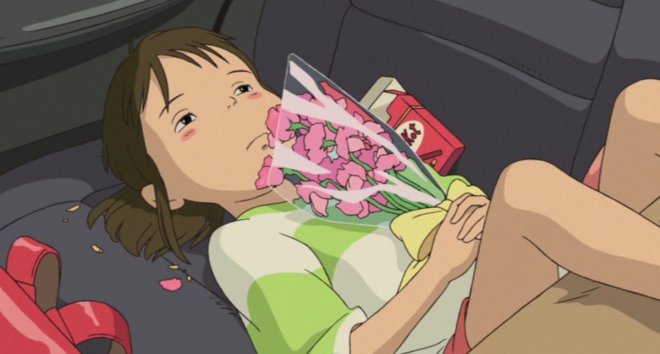
Another thing that struck me about the art in Spirited Away are the colors. When you think of Spirited Away, what color(s) quickly come to mind? For me, I immediately think of the color red. Sen’s outfit is red, the bathhouse itself is red, and even some of the spirits are red. I don’t know if this was a conscious choice, but it’s certainly interesting that no other Miyazaki movie has such a dominant color in its palette.
Now the aspect of the film that typically receives the most acclaim is the set and especially, character designs. To add my voice to the singing of its praises would be unnecessary, but I’m going to do it anyway. The world of Spirited Away is bursting at the seams with creativity, artistry, and imagination. The beautifully painted landscapes and the wonderfully atmospheric, mysterious buildings in both the spirit world and the human world are simply unbelievable. It all feels incredibly, magically real; and part of that is due to the characters inhabiting it. There’s chicken spirits, radish spirits, giant babies, stink monsters, masked apparitions, a man with eight arms, and much, much more. It sounds impossible that all these creatures can live together in the same world and be in the same movie in a logical way, but somehow it works, and just adds to the magic.
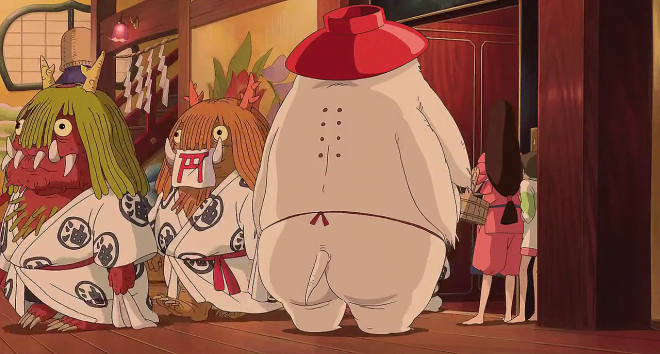
Spirited Away is also multilayered with many themes and messages including ones about growing up, gaining new responsibilities, becoming independent, loneliness, friendship, trust, et cetera. But ever relatable to me, is the theme of moving to a new place and trying to fit in. Starting off scared and homesick, Chihiro eventually warms up to the spirit world and, by the end, actually feels a small sense of heartache leaving it. I really relate to this because I also sort-of had an experience of moving to a new place by myself and leaving behind my close family and friends. I went to an art “summer camp,” over 300 miles away from my home for four weeks. Of course, it was nothing close to the fantastic and frightening adventure that Chihiro has, but this first time away from home for me (for more than a few days) did conjure up similar feelings of homesickness, loneliness, and anxiety in me, at least at first. By the program’s end, though, I couldn’t bear to leave it.
Now let’s take a closer look at Chihiro. I spent a lot of time thinking about why I enjoyed her character so much, and the thing is, she starts off very apathetic, really whiny, and constantly crying. But what makes her still likeable regardless is that we understand why she is acting and feeling this way. Like I mentioned earlier, from just the first 10 seconds of the film, we learn that she is moving away and that she is displeased about it because she is leaving behind friends. Her reason for being unhappy or “whiny” is made clear to us from the start and we are able to relate to her as a result. Being scared, having seemingly everyone against you, being forced to face new and sometimes scary things, and not being able to fit in—these are all part of the experience of moving to a new place, and they’re all things almost everyone can relate to. But by the end of the movie, Chihiro doesn’t just remain victim to all of these challenges; she grows up, becomes independent, and learns to face her fears and resolve them.
One scene near the beginning of the movie and one scene towards the end of the movie work very well together in showing this growth. The first scene shows Chihiro running down a flight of stairs, screaming at the top of her lungs and crashing into a wall at the foot of the steps. While not badly hurt, she is clearly shocked. The second scene, near the end of the movie, shows Chihiro running down a flight of stairs, while leading another character, and lightly bumping into a wall at the foot of the staircase. However, this time, she is not screaming and she instantly recovers and continues running without skipping a beat. The character she was leading down the stairs crashes into the wall and is undeniably flustered. I just love the parallelism between these two scenes and the way they subtly and visually show just how much Chihiro has grown.
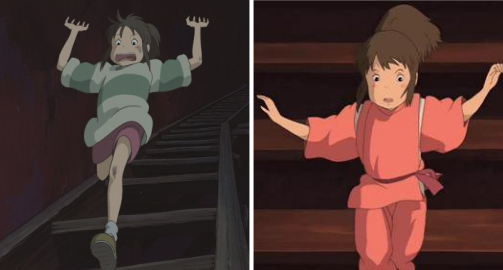
Another prevalent theme I found in the film that I haven’t seen anyone else mention—and is very relevant to today’s society—is discrimination. When Chihiro is first admitted into the bathhouse and given a job, she is constantly being rejected, neglected, and harassed by spirits for the sole reason that she is a “human.” Not only is there a theme here about trying to fit in with others, but I think there is also a message here about unfounded prejudice. By the end of the film, however, the spirits learn to value Chihiro, not for her “race” (i.e. human), but for her inner character: for her dedicated work ethic, her friendliness, and for her integrity. Thus, the film is not just a journey of maturation for Chihiro, but a journey of maturation for the spirits as well.
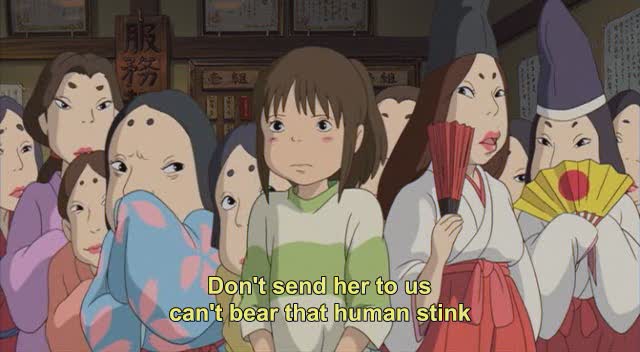
I also really admire Spirited Away for not being afraid of leaving questions open: it confidently does things without explicitly explaining what or why. There are all kinds of creatures and characters in the film that we don’t learn much about, yet you can still imagine long histories and interesting lives behind them. There are many buildings, areas, and other physical parts and non-physical laws and ideas in the spirit world that are strange and unexplained. And many people might find that these unexplained things leave them feeling unsatisfied by the film’s conclusion, but for me, they added layers and depth to the characters and the world. I am in awe of how vast and mysterious the spirit world feels even after going through a whole adventure within it. Sure, there are many unexplained things, but in my opinion, none really need to be explained.
Spirited Away is a marvelous, absolutely spellbinding animated film. The characters are so well-developed and well-written, the world is unbelievably imaginative, the music is beautiful, and the animation is breathtaking. I honestly don’t have any issues with this movie, nor have I found any glaring or even subtle flaws with it. Spirited Away affects me emotionally, it constantly gives me goosebumps, and it just completely blows my mind the amount of work, thought, and love that is so evidently imbued into its production. For that, it is nothing short of a masterpiece.
verdict: A+

